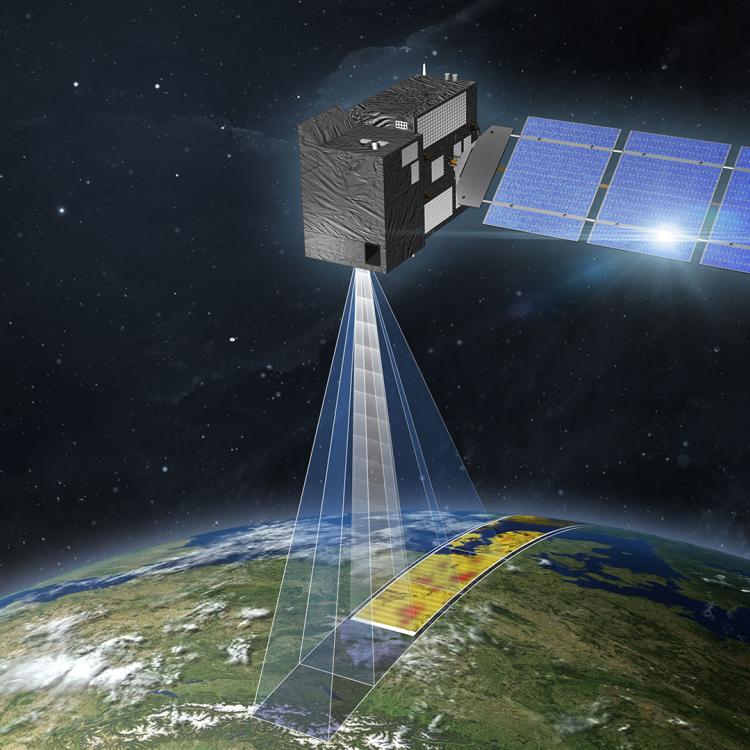28 March 2023
25 February 2021
The key challenge for the CO2M mission will be the high level of precision and accuracy that is required for detecting the small signals of enhanced greenhouse gas concentrations from anthropogenic emissions. This will not be achievable without an operational cal/val concept that relies on fiducial reference measurements from ground-based reference networks that observe the same quantity as the satellite instrument: column-averaged dry-air mole fraction of CO2 and CH4 (called XCO2 and XCH4, respectively).
Currently, two ground based networks provide XCO2 and XCH4 observations: the Total Carbon Column Observing Network (TCCON) and the COllaborative Carbon Column Observing Network (COCCON). TCCON has been operating since 2005 and consists of 27 stations worldwide. It has been the reference cal/val network for the OCO-2, OCO-3, GOSAT and S5P satellite missions. COCCON was established in 2014 and consists of 12 permanent stations and a number of mobile instruments that are used for campaigns. In general, the TCCON instruments have a higher spectral resolution, and provide the most accurate reference observations for XCO2 and XCH4 on a long-term basis. The COCCON instruments have lower resolution but are more compact and mobile. They are ideal for observing point sources. Both networks are scientific rather than operational. The study assessed their current operational readiness for CO2M cal/val, especially for their respective European components. It also proposed steps towards a higher operational level that would be fit-for-purpose for a future CO2M cal/val system.
Objectives
- Identify existing components and infrastructure of the European component of TCCON and COCCON, which are fit-for-purpose to support the operational cal/val of CO2M during commissioning, but in particular during the continuous operations phase.
- Make proposals for required improvements of data-handling, transmission, processing, (software) maintenance, and operations of network data to facilitate the needs of operational cal/val for CO2M.
Overview
The study addressed several aspects of the operational state of the ground based networks which will be crucial for a future operational CO2M cal/val system. The topics below were included in the Final Report.
Overview of global column GHG cal/val networks
This section describes the Total Carbon Column Network (TCCON) and the Collaborative Carbon Column Observing Network (COCCON). Special emphasis is put on their respective European components. Their instrumental concepts are compared: high resolution and stationary for TCCON and low resolution and more mobile for COCCON. Organisational structures, aspects of network policy and the respective data and software licences are described.
Methods for identification of needs for CO2M cal/val
The basis for a gap analysis between the current state of the networks and the requirements for the CO2M mission are laid out. The section provides a detailed list of station, instrument and network properties that could be examined in follow-up studies. A special emphasis is put on the capabilities of the networks for future emission monitoring. Requirements for necessary tools to address these questions are described.
TCCON algorithms, data processing, auxiliary data and spectroscopy
TCCON is used as an example to illustrate the current data processing scheme. Auxiliary datasets like meteorological fields and spectroscopic line lists and the different data processing levels are described in detail. This is based on the currently operational GGG2014 data processing software which will be replaced by the updated GGG2020 release within the next months.
Network design for processing, data transfer and operations
The planned CO2M cal/val concept may require different levels of data delivery timeliness, from months to hours. The capability of the current networks is analysed and cost and necessary effort to meet faster delivery requirements are estimated. The section also describes data processing options for faster data delivery timeliness and integration into a future operational CO2M cal/val scheme.
Reference standard (network monitoring)
This section describes measures and procedures that are suitable for improving data product quality consistency and that reduce bias between stations. Many of the measures are already employed in the current networks.
Product Quality Assurance
The TCCON and COCCON networks follow internal data quality assurance procedures that are outlines in this section.
Required network upgrades: Towards operational CO2M cal/val and monitoring
The final section lists key aspects of a future operational CO2M cal/val network and recommendations for its realisation. The importance of network design tools that are able to include the special properties of the TCCON and COCCON networks, as well as the requirements of CO2M are highlighted. The recommendations are the basis for follow-up studies that assess and implement the steps towards an operational CO2M cal/val system.




